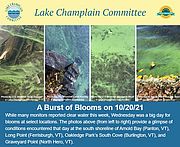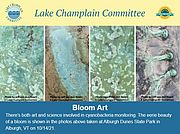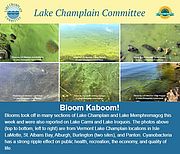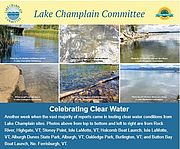Wetlands are vital natural resources that must be protected and restored for Vermont to address the impacts of climate change, protect wildlife habitat, restore, and maintain the quality of our waters, and provide other benefits for people and nature. In light of their significance, we believe the state of Vermont must commit to a “net gain” of wetlands. Read...
News from Selected Month
While color is fading on the hillsides, it unfortunately is still showing up in the water. October 20 was a particularly busy day for cyanobacteria sightings with blooms reported at a scattering of locations up and down Lake Champlain. Scroll through this email to view pictures of the conditions witnessed at Arnold Bay, Burlington beaches, Island sites, St. Albans Bay, and Lake Memphremagog during this 18th week of cyanobacteria monitoring. You’ll also find some visuals and details about duckweed, water samples rimmed with cyanobacteria, and resources and links to help you recognize, avoid, and report cyanobacteria. Read...
Unfortunately, this was another big week for blooms—with reports of cyanobacteria coming in from all sections of Lake Champlain except Malletts Bay, Missisquoi Bay, and the South Lake. Blooms were also reported from Clyde Pond, Lake Carmi, Lake Iroquois, Lake Memphremagog, and Shelburne Pond. We have fewer monitors watching the water at this time of year but blooms can still show up as evidenced by the reports and photos compiled from this week. Please use the resources and links in this email to learn how to recognize, avoid, and report cyanobacteria. Read...
Unfortunately, this was a big week for blooms—reports of cyanobacteria were chronicled at all Lake Champlain sections except the South Lake and Malletts Bay. Blooms expanded in many areas of Lake Memphremagog and were reported on Lake Carmi and Lake Iroquois. You can get a sense of the impact of a bloom by watching this video taken on 10/6/21 by Missisquoi National Wildlife Refuge Manager Ken Sturm. Ken and his team witnessed an extensive swath of dense cyanobacteria in Missisquoi Bay during a 20-minute boat ride from the east delta all the way around to Long Marsh Bay. Read...
Monday, October 4th 2021
To the Vermont Climate Council,
...Significant parts of the world are literally on fire, and big portions of the rest of the nation are (or were recently) underwater. Vermont itself has recently missed being hit by not one but two massive tropical storms by mere miles, and earlier forecasts for the path of both Henri and Ida warned they might go directly through our state. And, of course, Vermonters are already experiencing more extreme heat and heavy precipitation events climate scientists have predicted for years. Read...
Clear water dominated on the cyanobacteria tracker during this first full week of fall and the 15th week of the cyanobacteria monitoring program. Most monitors who are still able to report recorded safe conditions, great for late-season recreation. Cyanobacteria was reported at one site each in Lake Champlain’s Main Lake Central and Main Lake South sections and several times during the week at Lake Carmi. Read...




